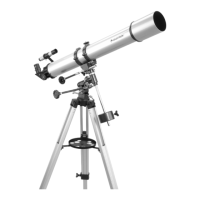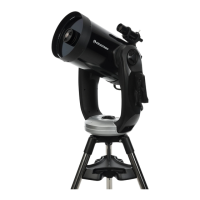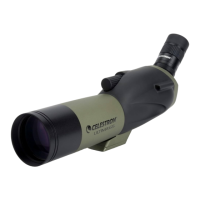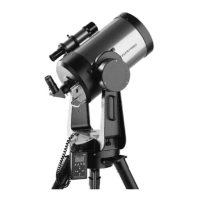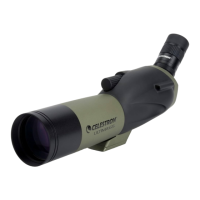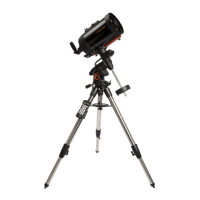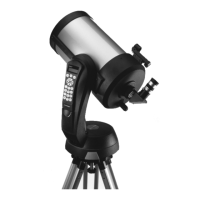Do you have a question about the Celestron Ultima 8 and is the answer not in the manual?
Crucial safety precautions for observing the Sun, including filter use and eye protection.
Learn to navigate the telescope's hand control interface and menus.
Steps for aligning and tracking celestial objects for initial observations.
Instructions for stable tripod setup and height adjustment for optimal viewing.
Guidance on adjusting tripod leg height for stability and viewing comfort.
Guides on mounting the telescope, installing the finder, visual back, and diagonal.
Procedures for dynamically balancing the telescope and adjusting altitude/azimuth clutches.
Steps for attaching an equatorial wedge and inserting power source batteries.
Recommendations for proper storage to protect the telescope and optics.
Overview of hand control buttons, main menu structure, and command tree navigation.
Detailed steps for scrolling through menus and locating celestial objects like Messier objects.
Explanations for ALIGN, GO TO, CATALOG, POSITION, IDENTIFY, TIMER, SETUP, and TOUR menus.
Explanation of the telescope's optical design and light path.
How image orientation changes and guidance for the initial viewing experience.
Formulas and guidance for calculating telescope magnification and field of view.
General tips for visual observation and basic photography techniques.
Understanding Right Ascension (RA) and Declination (DEC) for locating celestial objects.
Explanation of apparent star movement caused by Earth's rotation.
Methods for achieving polar alignment, including finding Polaris and using latitude scales.
Techniques for accurate alignment using declination drift and the 7x50mm finderscope.
How to turn tracking on/off, change slewing speeds, and save power.
Procedures for determining and setting backlash compensation and finding 90º declination.
Step-by-step guide for performing a two-star sky alignment.
Procedure for one-star alignment in the Northern hemisphere with a wedge.
Method for updating the telescope's alignment during an observing session.
Procedure to replace existing alignment stars with new ones.
A rough alignment method for situations with limited visible stars.
Steps for aligning the telescope to terrestrial objects for general use.
Aligning to user-defined terrestrial objects stored in the NEW database.
Command to slew the telescope to a selected object in the catalog.
Method for accurate pointing using a reference star search.
Guidance and tips for observing various celestial bodies.
Information on viewing deep-sky objects and understanding atmospheric seeing conditions.
Understanding atmospheric seeing, transparency, and sky illumination effects on viewing.
Requirements and overview of different celestial photography types.
Techniques for capturing lunar/solar images without an eyepiece.
Capturing deep-sky objects and constellations with a camera riding on the telescope.
Methods for high-magnification imaging of planets and the Moon.
Techniques for deep-sky astrophotography requiring polar alignment and long exposures.
Using CCD cameras and exploring different f-number configurations for imaging.
Advantages of imaging at different f-numbers and required equipment.
Instructions for cleaning optical surfaces to maintain performance.
Steps for maintaining mirror alignment for optimal optical performance.
List and descriptions of accessories available for the telescope.
A comprehensive list of stars suitable for telescope alignment procedures.
A reference for common abbreviations used for celestial constellations.
A catalog of named celestial objects for easy identification and locating.
Settings and cable requirements for connecting the telescope to a PC.
List and description of commands for controlling telescope functions via PC.
Detailed optical parameters including aperture, focal length, and resolution.
Information on drive systems, encoders, weight capacity, and power requirements.
Tips on backlash compensation, auto guiding, and handling zenith viewing issues.
How star diagonals affect pointing and guidelines for viewing near zenith.
Managing cord wrap issues and using the slewing autostop feature.
Crucial safety precautions for observing the Sun, including filter use and eye protection.
Learn to navigate the telescope's hand control interface and menus.
Steps for aligning and tracking celestial objects for initial observations.
Instructions for stable tripod setup and height adjustment for optimal viewing.
Guidance on adjusting tripod leg height for stability and viewing comfort.
Guides on mounting the telescope, installing the finder, visual back, and diagonal.
Procedures for dynamically balancing the telescope and adjusting altitude/azimuth clutches.
Steps for attaching an equatorial wedge and inserting power source batteries.
Recommendations for proper storage to protect the telescope and optics.
Overview of hand control buttons, main menu structure, and command tree navigation.
Detailed steps for scrolling through menus and locating celestial objects like Messier objects.
Explanations for ALIGN, GO TO, CATALOG, POSITION, IDENTIFY, TIMER, SETUP, and TOUR menus.
Explanation of the telescope's optical design and light path.
How image orientation changes and guidance for the initial viewing experience.
Formulas and guidance for calculating telescope magnification and field of view.
General tips for visual observation and basic photography techniques.
Understanding Right Ascension (RA) and Declination (DEC) for locating celestial objects.
Explanation of apparent star movement caused by Earth's rotation.
Methods for achieving polar alignment, including finding Polaris and using latitude scales.
Techniques for accurate alignment using declination drift and the 7x50mm finderscope.
How to turn tracking on/off, change slewing speeds, and save power.
Procedures for determining and setting backlash compensation and finding 90º declination.
Step-by-step guide for performing a two-star sky alignment.
Procedure for one-star alignment in the Northern hemisphere with a wedge.
Method for updating the telescope's alignment during an observing session.
Procedure to replace existing alignment stars with new ones.
A rough alignment method for situations with limited visible stars.
Steps for aligning the telescope to terrestrial objects for general use.
Aligning to user-defined terrestrial objects stored in the NEW database.
Command to slew the telescope to a selected object in the catalog.
Method for accurate pointing using a reference star search.
Guidance and tips for observing various celestial bodies.
Information on viewing deep-sky objects and understanding atmospheric seeing conditions.
Understanding atmospheric seeing, transparency, and sky illumination effects on viewing.
Requirements and overview of different celestial photography types.
Techniques for capturing lunar/solar images without an eyepiece.
Capturing deep-sky objects and constellations with a camera riding on the telescope.
Methods for high-magnification imaging of planets and the Moon.
Techniques for deep-sky astrophotography requiring polar alignment and long exposures.
Using CCD cameras and exploring different f-number configurations for imaging.
Advantages of imaging at different f-numbers and required equipment.
Instructions for cleaning optical surfaces to maintain performance.
Steps for maintaining mirror alignment for optimal optical performance.
List and descriptions of accessories available for the telescope.
A comprehensive list of stars suitable for telescope alignment procedures.
A reference for common abbreviations used for celestial constellations.
A catalog of named celestial objects for easy identification and locating.
Settings and cable requirements for connecting the telescope to a PC.
List and description of commands for controlling telescope functions via PC.
Detailed optical parameters including aperture, focal length, and resolution.
Information on drive systems, encoders, weight capacity, and power requirements.
Tips on backlash compensation, auto guiding, and handling zenith viewing issues.
How star diagonals affect pointing and guidelines for viewing near zenith.
Managing cord wrap issues and using the slewing autostop feature.
| Focal Ratio | f/10 |
|---|---|
| Optical Design | Schmidt-Cassegrain |
| Highest Useful Magnification | 480x |
| Lowest Useful Magnification | 29x |
| Resolution (Rayleigh) | 0.69 arc seconds |
| Resolution (Dawes) | 0.57 arc seconds |
| Light Gathering Power | 843x |
| Aperture | 203 mm (8 in) |
| Focal Length | 2032 mm |
| Limiting Stellar Magnitude | 14.0 |
| Secondary Mirror Obstruction | 63.5 mm (2.5 in) |
| Optical Tube Length | 432 mm (17 inches) |
